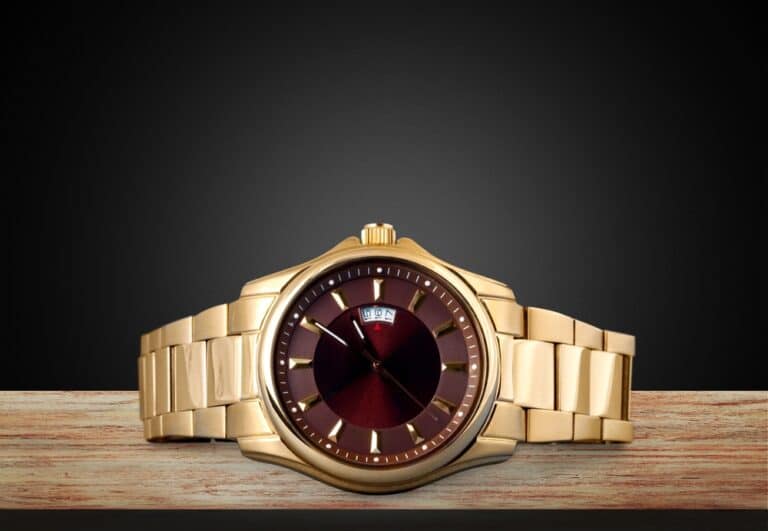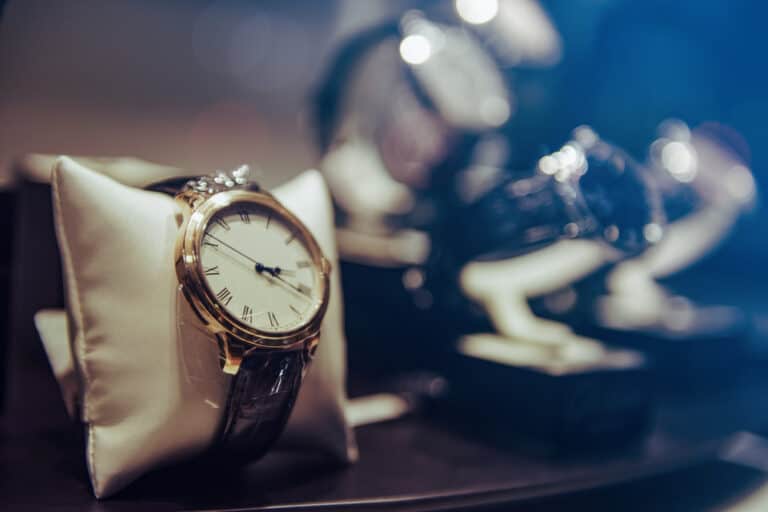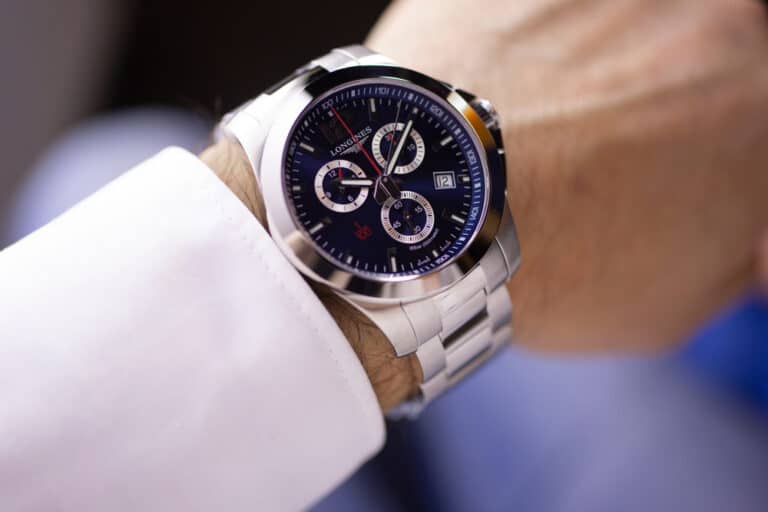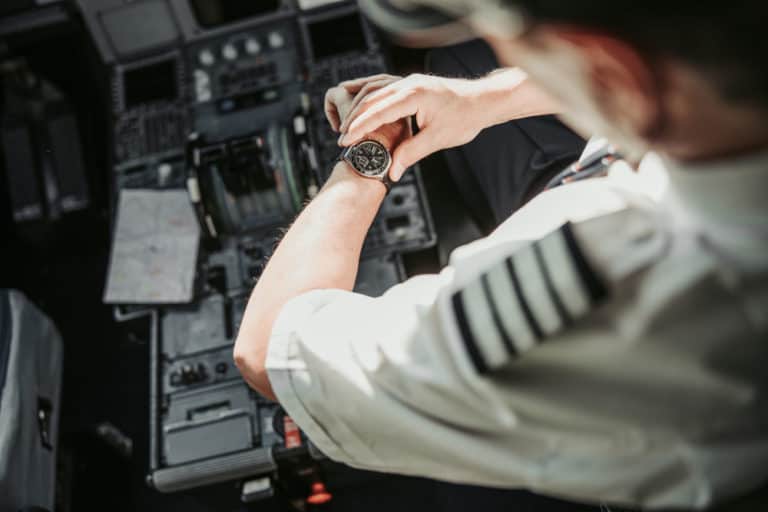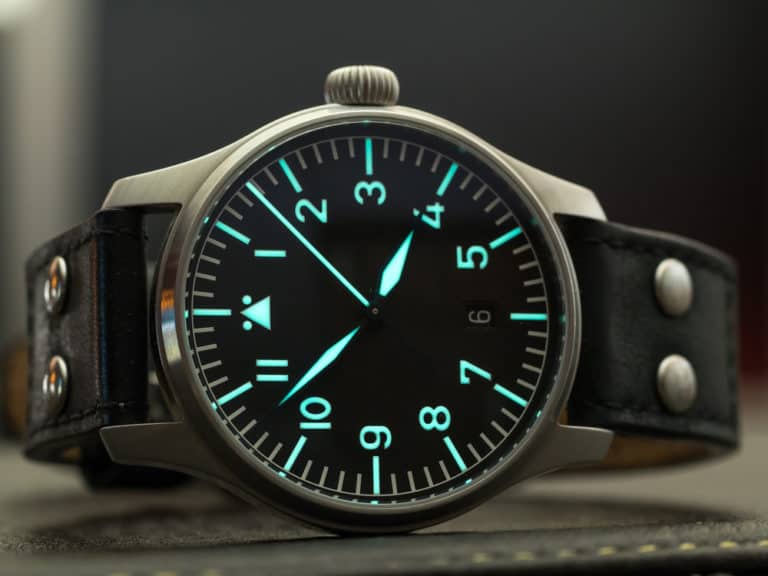The first quartz watch was made available to the public at the end of 1969 and revolutionized watch-making – or horology – which had been limited to mechanical watches. Quartz watches are battery-powered and use the piezoelectric properties of quartz crystals and a stepper motor, making these electro-mechanical watches reliable time-keepers.
Quartz watches can be analog or digital. An analog quartz watch consists of many tiny mechanical parts driven by a power source. Digital quartz watches use the same power source as their analog counterparts but have fewer parts due to their preprogrammed microchip circuits.
An analog watch has many moving parts behind the display. These moving parts can be seen as an engine for the watch, and their collective name is a movement. Depending on the watch’s complexity, the movement of these mechanical watches can total over one hundred and thirty parts.
The Parts Inside An Analog Quartz Watch
Inside any analog watch, three sub-assemblies form the movement. Within each sub-assembly, miniaturized parts are carefully assembled to perform the function of that sub-assembly. Each tiny part plays a vital role in the function of the analog watch, meaning none are obsolete.
The three sub-assemblies inside a watch are the energy source and the regulating parts. A third sub-assembly – the display – is made up of components inside the watch, as well as on the actual display of the watch.
The Energy Source In An Analog Quartz Watch
Quartz watches revolutionized the world of horology when they became available in 1969. Before, analog watches were mechanical and needed to be wound up daily. Later, automatic winding watches became available. Mechanical and automatic watches risk being unreliable, especially if you forgot to wind up your watch daily or didn’t move enough.
Quartz has piezoelectric properties and vibrates at a consistently precise frequency of 32,768 Hz when current moves through it. Quartz also gives off a charge when it vibrates, meaning it effectively charges itself under the right circumstances. By harnessing this precision, the energy source of a quartz watch contains the following:
A Small Battery
A small battery is needed to provide a current or charge to the quartz crystal. Most modern watches use a silver oxide battery with a charge of 1.55V. The charge is sent to a microchip circuit, which sends the charge to the quartz.
The Quartz Crystal And The Crystal Oscillator
The quartz crystal in a quartz watch is precision-cut to the shape of a little tuning fork. This tiny tuning fork is housed in a crystal oscillator or resonator that creates a mini electrical circuit for the piezoelectric crystal, effectively keeping itself going. With the charge from the battery via the circuit, the quartz starts and continues to vibrate at 32,768 oscillations per second.
These pulses are then sent to the microchip circuit that starts with the regulating process.
The Regulating Parts In An Analog Quartz Watch
The preprogrammed microchip circuit receives 32,768 electrical pulses per second, does some quick division, and sends one pulse per second to the electro-mechanical stepper motor or counter, which converts electrical pulses to mechanical movement.
The stepper motor used in electro-mechanical watches is a Lavet-type stepper motor. The Lavet motor is a single-phase motor that can only move in one direction. The stepper motor plays the role of the balance wheel, hairpin, and escapement in a fully mechanical analog watch, setting the gear train in motion.
The gear train comprises various cogs that transmit mechanical energy to the dial train on a simple watch, and the sub-dial trains in a complex or grand complication watch.
The Display Parts In An Analog Quartz Watch
As mentioned, the display parts of a quartz analog watch are not just what you can see on the face of the watch. Under each display, there is a dial train that guides the hands of a simple watch – that is, one that shows the hour, minute, and maybe second hands. A sub-dial will be needed for each additional display.
Additional displays on an analog watch include a chronograph (date display), a chime, a stopwatch, or an astronomical indicator (sun or moon). Each sub-dial would need a sub-dial train because they work on different cycles.
An analog watch that has an additional display is called a complex watch. Watches that have more than one additional display are called grand complication watches. Grand complication watches probably look very complicated behind the display with all those additional cogs and sub-dial trains, hence their name.
It is possible to see why an analog clock could have so many parts, with the assembly being made up of sub-assemblies, which are, in turn, made up of many tiny parts that all work together. The parts outside the watch haven’t even been accounted for!
The Parts Inside A Digital Quartz Watch
A digital quartz watch has fewer parts than its analog counterpart, but the power source and regulating parts are the same. This means that a digital quartz watch has:
- A 1.55V battery that provides a current that is supplied to the quartz crystal,
- A preprogrammed microchip circuit that moderates the electrical current to and from the crystal,
- A tuning-fork-shaped quartz crystal in a crystal oscillator or resonator forms a mini electrical circuit that powers itself and oscillates at 32,768 vibrations per second, and
- A counter, or stepper, converts the electrical pulses received from the quartz via the microchip circuit and creates a binary number. The microchip circuit then converts this to hours, minutes and seconds.
Afterward, a signal is conducted electronically to the display, where things differ from an analog clock. With the power source and regulating parts almost the same, how do the display parts of a digital quartz watch differ from the analog gear train and dial train, and how many parts are there?
The Parts Of A Display Assembly In A Digital Quartz Watch
A digital quartz watch’s liquid crystal display (LCD) does not require a gear train and dial train to operate. The stepper motor transmits a pulse to the microchip using a binary number. The preprogrammed microchip will convert the binary numbers received at specific intervals to a message sent to various parts of the LCD screen.
Through the electrical impulses received from the preprogrammed microcircuit, the liquid crystal encapsulated in the display will turn off or on, depending on the impulses received, thereby giving us a visual translation of the code programmed into the microchip. So that means the display sub-assembly is just a circuit with an LCD.
The automatic time-keeping ability of quartz watches, whether digital or analog, is much more accurate (over an extended period) than others because of the reliability of quartz and the tiny amount of battery power it draws. Depending on ambient temperature and air pressure, a quartz watch may gain or lose a few seconds over a year.

Conclusion
The parts in an analog quartz watch are more plentiful than those in a digital quartz watch. The components in the display sub-assembly of analog watches contain many mechanisms, whereas digital watches use circuit boards. Analog and digital quartz watches are powered by an electrical current provided by a battery that gives charge to a piezoelectric crystal – quartz.
References
- https://electronics.howstuffworks.com/gadgets/clocks-watches/difference-between-quartz-and-liquid-crystal.htm#
- https://en.wikipedia.org/wiki/Lavet-type_stepping_motor#
- https://www.explainthatstuff.com/quartzclockwatch.html
- https://www.fhs.swiss/eng/mechanical-quartz.html
- https://www.seikowatches.com/global-en/products/astron/special/story_qa50th_1#

